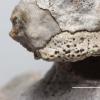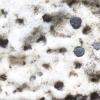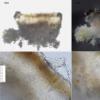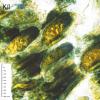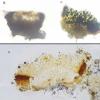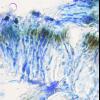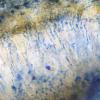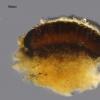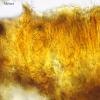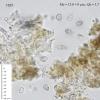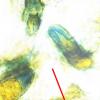
09-12-2025 12:06
 Andgelo Mombert
Andgelo Mombert
Bonjour,Je recherche l'article concernant Hypobryo

07-12-2025 16:07
Arnold BüschlenHallo, ich habe in einer Moos-Aufsammlung (epiphy

08-12-2025 21:04
Mark Stevens"Hello everyone,I'm relatively new to microscopy (

08-12-2025 18:59
 Lothar Krieglsteiner
Lothar Krieglsteiner
.. found by a seminar-participant, I do not know t

08-12-2025 17:37
 Lothar Krieglsteiner
Lothar Krieglsteiner
20.6.25, on branch of Abies infected and thickened

16-03-2014 22:00
Hello,I found this species a few months ago but ha

08-12-2025 13:39
Thomas Læssøehttps://svampe.databasen.org/observations/10572899
Hymenelia prevostii/Clauzadea immersa
Gonzalez Garcia Marta,
30-03-2025 10:24
Crustaceous thallus, endolithic, with black apothecia when dry, brown when wet, which remain submerged in the limestone when mature. Hypothecium light-coloured with brown epithecium, hymenium I- (non-amyloid), but with I+ (dextrinoid), I- asci on Melzer (hemiamyloid?). Spores unicellular, hyaline. Year: 11 x 6.3 microns (sporal measurements within asci). Excipulum or apothecial margin black, N-. Photobiont of green algae.
Zdenek Palice,
30-03-2025 11:54
Re : Hymenelia prevostii (Duby) Kremp.
Dear Marta,
from your pictures it makes impression to me that apothecia are pruinose and asci have amyloid structures in apical part - I think these features exclude Hymenelia. You may still check for paraphyses (they should be apically constricted at septa in Hymenelia - submoniliform). One of the options is that your sample will belong to a segregate of Lecanora, currently called Myriolecis or Polyozosia (on Italic web), at least one taxon/or?form from the Myriolecis agardhiana aggregate may form apothecia without thalline margin, it was described as Lecanora lecidella Poelt, and on Italics web this name is treated within synonymy (with ?) of Myriolecis/Polyozosia agardhiana subsp. sapaudica. The complex is nomenclaturally and taxonomically complicated and needs revision and I am not familiar with it at all, nor sure whether your sample is Myriolecis/Polyozosia at all, just an idea. Probably Claude Roux knows these lichens quite well.
All the best
Zdenek
from your pictures it makes impression to me that apothecia are pruinose and asci have amyloid structures in apical part - I think these features exclude Hymenelia. You may still check for paraphyses (they should be apically constricted at septa in Hymenelia - submoniliform). One of the options is that your sample will belong to a segregate of Lecanora, currently called Myriolecis or Polyozosia (on Italic web), at least one taxon/or?form from the Myriolecis agardhiana aggregate may form apothecia without thalline margin, it was described as Lecanora lecidella Poelt, and on Italics web this name is treated within synonymy (with ?) of Myriolecis/Polyozosia agardhiana subsp. sapaudica. The complex is nomenclaturally and taxonomically complicated and needs revision and I am not familiar with it at all, nor sure whether your sample is Myriolecis/Polyozosia at all, just an idea. Probably Claude Roux knows these lichens quite well.
All the best
Zdenek
Gonzalez Garcia Marta,
30-03-2025 22:03
Re : Hymenelia prevostii (Duby) Kremp.
Dear Zdenek Palice
Thank you very much for your comment. I have studied the paraphyses in lactophenol blue and they are not submoniliform. They are septate and sparsely branched.
After your comment, it occurred to me to use Italic 8.0 key 85 of 'Lecideoid crustose lichens' and I found Clauzadea immersa. I don't understand why I haven't used this key before!
I attach a photo of the paraphysis and the hymenium in melzer.
Thank you very much again.
All the best.
Thank you very much for your comment. I have studied the paraphyses in lactophenol blue and they are not submoniliform. They are septate and sparsely branched.
After your comment, it occurred to me to use Italic 8.0 key 85 of 'Lecideoid crustose lichens' and I found Clauzadea immersa. I don't understand why I haven't used this key before!
I attach a photo of the paraphysis and the hymenium in melzer.
Thank you very much again.
All the best.
Marta.
Zdenek Palice,
30-03-2025 22:45
Re : Hymenelia prevostii (Duby) Kremp.
Yes, Clauzadea immersa sounds like a good choise, it was likely just impression, indeed, the apothecia are pruinose, I was not able to see clearly any tube-structure in ascus tip before, but they seem to be visible (though not so clearly) in one of the new series of photos. the ascospores (if not too old) may have distinct perispore, according to monographer of the group (Meyer 2002, Sendtnera) the perispore is even ornamented in this species, but this is probably hard-to see inside asci
best wishes
Zdenek
best wishes
Zdenek
Gonzalez Garcia Marta,
31-03-2025 21:56
Re : Hymenelia prevostii/Clauzadea immersa
Hello again, Zdenek.
I have added more light to one of the photos, where the apical K/I reaction (Porpidia-type) is better appreciated. As for the ornamentation of the spores, I didn't see it, only their halo. According to Meyer, only mature spores have it. I found it difficult to distinguish C. immersa from C. metzleri, but the spores of the latter species look somewhat different in the drawings Meyer includes in his monograph.
Thank you very much for your help.
Best regards.
I have added more light to one of the photos, where the apical K/I reaction (Porpidia-type) is better appreciated. As for the ornamentation of the spores, I didn't see it, only their halo. According to Meyer, only mature spores have it. I found it difficult to distinguish C. immersa from C. metzleri, but the spores of the latter species look somewhat different in the drawings Meyer includes in his monograph.
Thank you very much for your help.
Best regards.
Alain GARDIENNET,
01-04-2025 17:54
Re : Hymenelia prevostii/Clauzadea immersa
Clauzadea immersa, very probably. The 2 species are indeed close but C. immersa is more deeply endolithic, and hypothecium is dark brown in C. immersa and light brown in C. meltzeri. Thus, the latter often comes on very small stones.
Gonzalez Garcia Marta,
01-04-2025 21:50
Re : Hymenelia prevostii/Clauzadea immersa
Hi Alain, I don't think macro photos 3 and 4 are the same species. I was naive, thinking all the apothecia on the rock were the same. In fact, I also found perithecia. Thank you very much.


